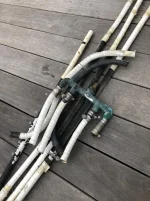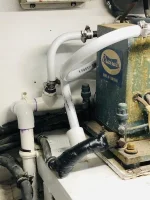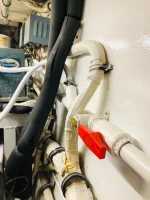racclarkson@gmail.com
Legendary Member
- Joined
- Aug 6, 2015
- Messages
- 3,722
- Status
- OWNER - I own a Hatteras Yacht
- Hatteras Model
- 55' CONV -Series I (1979 - 1988)
Been wanting to get rid of what could be OEM black rubber hoses feeding and draining my four Cruisair HVAC's. Started pulling and kinda got into it. This is just some of the junk I pulled out.

I also junked my PCV feed manifold in favor of running 1" PVC pipe and tapping into the feed water at the individual units.

Hate to show the two older units, but awful proud they're still percolating at 37 years old!
So after addressing the feeder side, I ran a 1" PVC pipe behind the top rack and picked up the discharges along the way aft. While I was at it, I installed two ports for future descaling and a valve to close the discharge loop; the seacock will serve to close the intake portion of the loop. The brass plug is a temp.

Then the pipe goes to the ER rear bulkhead with a bit of fall where it picks up a hose to the transom discharge. Probably will replace that hose run with pipe and just use a foot or so of hose at the thru hull.
It sure looks a lot nicer, and I picked up some valuable wall space by getting rid of the old spaghetti. I rate the job a B+. That's the flavor blood I left all over the place. Hatt's ain't for hemophiliacs!

I also junked my PCV feed manifold in favor of running 1" PVC pipe and tapping into the feed water at the individual units.

Hate to show the two older units, but awful proud they're still percolating at 37 years old!
So after addressing the feeder side, I ran a 1" PVC pipe behind the top rack and picked up the discharges along the way aft. While I was at it, I installed two ports for future descaling and a valve to close the discharge loop; the seacock will serve to close the intake portion of the loop. The brass plug is a temp.

Then the pipe goes to the ER rear bulkhead with a bit of fall where it picks up a hose to the transom discharge. Probably will replace that hose run with pipe and just use a foot or so of hose at the thru hull.
It sure looks a lot nicer, and I picked up some valuable wall space by getting rid of the old spaghetti. I rate the job a B+. That's the flavor blood I left all over the place. Hatt's ain't for hemophiliacs!





